‘The glory of gardening: hands in the dirt, head in the sun, heart with nature. To nurture a garden is to feed not just the body, but the soul. ‘ Alfred Austin
So a new calendar year begins. In our valley, it has brought the birth of the first lambs and the passing of several pigs. It’s a cycle of life that plays out in the garden, too.
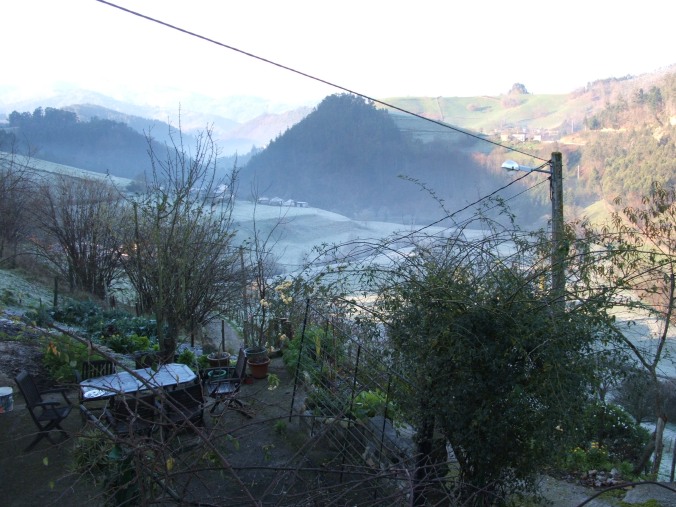
We’ve often quipped that our garden is the most important room in the house; in truth, it’s not so much a place as a way of life. Being able to spend time in the garden every day – whether working, harvesting or simply being – is one of the biggest blessings of our lifestyle here. Fresh food is another: we live like peasants yet dine as kings. Bliss. Sheer bliss.
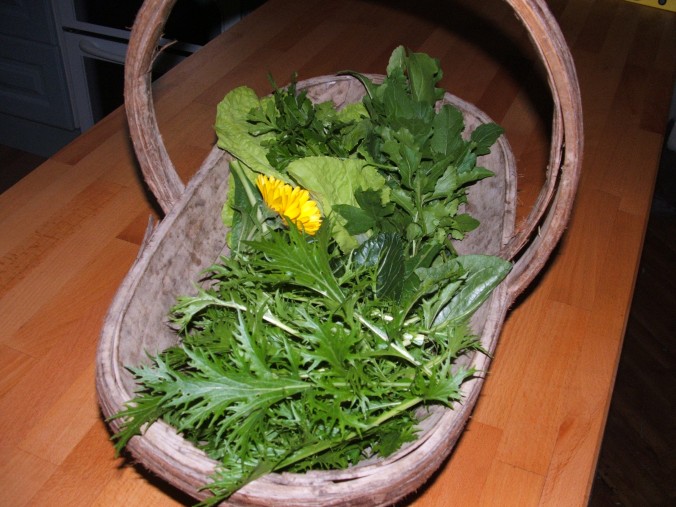
Mizuna, komatsuna, rocket, pak choi, coriander and calendula: a salad fresh from the garden on 2nd January.
As our time here flows through the seasons, we are learning and adjusting to a new climate; it still comes as a surprise that there is so much green and growth at this time of year. The grass is long and lush, the catkins are shaking pollen and the primroses have been flowering for weeks.


That said, we have felt the first cold fingers of winter and doubtless there is more to come. Nature needs a rest, after all.




Thinking about life cycles, one of the things we have always done in the garden is make compost. Now there is so much written about composting methods by people with far more expertise than me ( https://www.foe.co.uk/living/articles/making_great_compost_40212 ) but sometimes I wonder if would-be composters are put off by what can seem like some mysterious gardening alchemy? To me, it’s always been ‘dead’ simple, if you will excuse the pun: organic matter rots – a good thing too, else we’d all be buried under several miles of leaf mould (and worse). There are some wonderful compost bins around but really, a heap does the job just as well, if not as tidily, as long as there’s a healthy balance of wet greenstuff and dry brownstuff and a good supply of air. Our compost heap here was started in an emergency, crammed into a concrete corner as there just seemed nowhere else practical at the time.

It had grown and grown to the point where I decided last week to take a closer look and at the very least turn it over a bit. Given that it’s sitting directly on solid concrete, I had a feeling I would find either very little was happening . . . or a squidgy, slimy, wet mess at the bottom. How wrong could I have been? Lifting the top matter off revealed a good depth of lovely, crumbly, sweet-smelling compost, wriggling with worms.
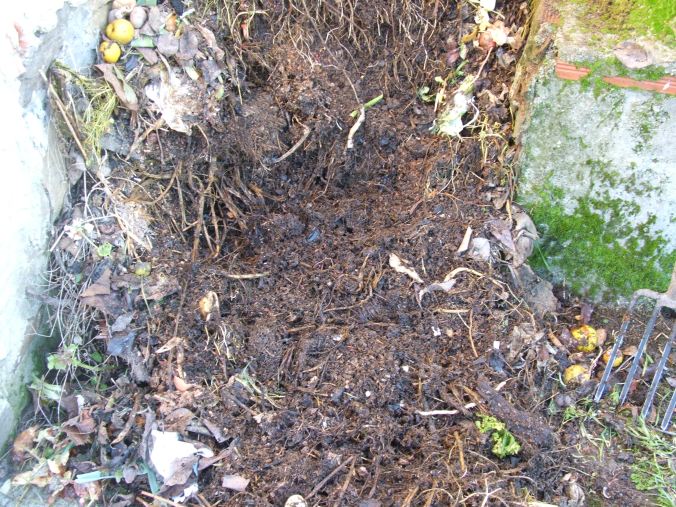
 Wow! Not bad in seven months. Although I would say we use the ‘cold’ method (actually, we use the ‘dump it all in a big pile’ method), the middle was incredibly warm and I was worried about disturbing slumbering grass snakes. Maybe the heap had adopted the ‘hot’ method through neglect? Who cares? It’s working brilliantly, and that’s all that matters. That compost will be the very best stuff for filling planting containers in spring . . . and the good news is, there is plenty more to come.
Wow! Not bad in seven months. Although I would say we use the ‘cold’ method (actually, we use the ‘dump it all in a big pile’ method), the middle was incredibly warm and I was worried about disturbing slumbering grass snakes. Maybe the heap had adopted the ‘hot’ method through neglect? Who cares? It’s working brilliantly, and that’s all that matters. That compost will be the very best stuff for filling planting containers in spring . . . and the good news is, there is plenty more to come.


From death to new life. The ‘Douce Provence’ peas I planted a few weeks ago have pushed tentative bright shoots through the ground, and in pots the sweet peas are not far behind. The broad beans are setting flowers – yes, flowers in January. That’s the great thing about gardening: there’s always something to look forward to.


I am passionate about gardening as organically as possible, by which I mean with nature, rather than against it. I know such a sentiment may cause mainstream gardeners to raise sardonic eyebrows, but for me personally it’s the only way. I sense enough noxious chemicals in modern living without me throwing them around the garden, too. Does that mean I’m happy for snails and caterpillars to devastate the brassicas? No, of course not. That would be naïve and counterproductive – I might like wildlife but I have no intention of starting a soup kitchen for slugs any time soon. What I have is a pragmatic approach. Garden ‘pests’ are part of a wider food chain: I can do things to encourage predators to come in and fill their boots and I take action myself to reduce numbers without resorting to chemical warfare. I can accept that we will lose some crops, but that’s life. No garden is perfect, nor should it try to be, surely? It’s hardly a hardship to spend an hour in the sunshine picking little beasties off plants, and if it ensures a plentiful supply of wholesome fresh food then it’s well worth the effort.

. . . 98, 99, 100. Coming ready or not, snails!


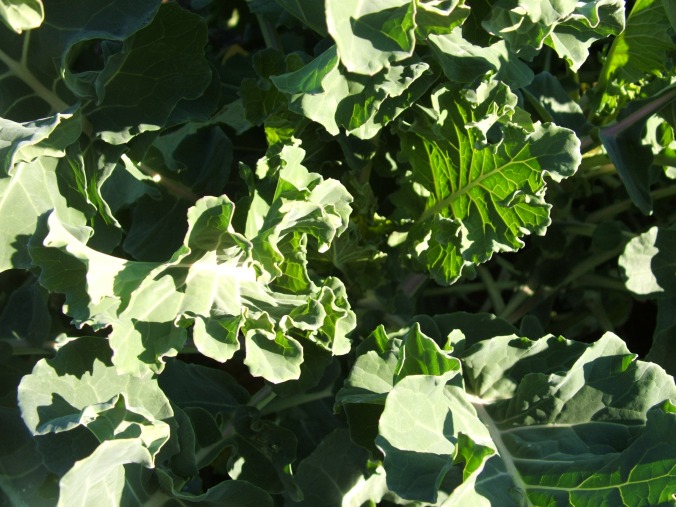
I love flowers and need no encouragement to plant them among the vegetables or simply let vegetables run to seed. As I draft this post in the garden, there are several bumble bees and hoverflies feeding in rocket and pak choi flowers in front of me, and honey bees working the calendula.


In fact, the air is full of insects like dust motes dancing in the afternoon sunshine, and a pair of tiny warblers is flitting through the patch and plucking a meal of flies out of the air.

Calendula is one of my favourite flowers and I am happy to let the clumps here spread themselves around as much as they want – they are so bright and cheerful, and great companion plants.
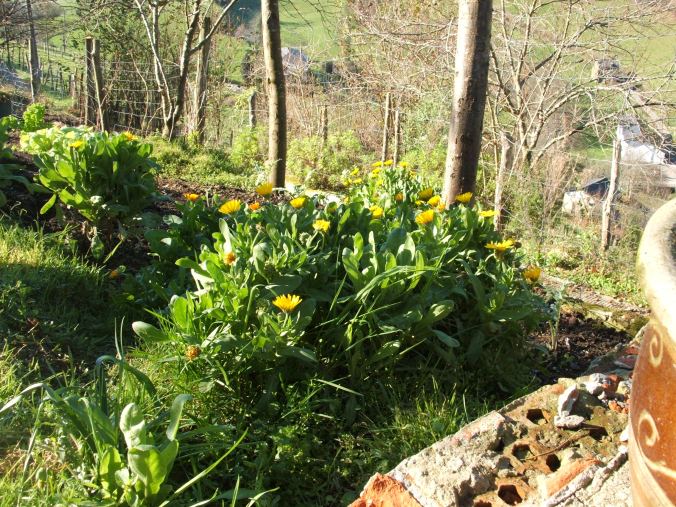
The same goes for nasturtiums and borage, although I do have to exercise a bit of control over the latter as its spreading habit gets me into all sorts of trouble. It has already broken out from the salad patch and colonised the concrete. Oh well, if you’re going to have a ‘weed’, best to have one that is useful and pretty!

This year I am planning to plant literally hundreds of French marigolds (tagetes) all over the vegetable garden; we have a lot of whitefly here – a result of the mild climate, I suspect – so I’m hoping they will act as a bit of a deterrent. We’ve been slowly clearing the fence line below the raspberries and I think this area will be perfect for some flowers – a wigwam of sweet peas, a stand of sunflowers, maybe some cosmea, hyssop, phacelia . . ? Colour and scent for us; another link in the food chain, too.

It seems strange not to be feeding the birds this winter. I haven’t found a supply of bird food anywhere but maybe that’s because there is still such an abundance of natural food around that they really don’t need any extra. The garden is full of birdlife as I write: several robins staking their aggressive claims to the muck heap and it’s wormy riches, a wren in the compost heap, a pair of vibrant bullfinches working the hedgerow amongst blue tits and great tits, blackbirds rummaging in fallen leaves, a family of long-tailed tits chattering through the peach trees and a flock of goldfinches picking the fluffy seedheads off groundsel. All helpful, all welcome.
We have another visitor, too. A bit cheeky, this one; he’s taken to sunbathing below the horreo.

Not the greatest asset to a wildlife-friendly garden I grant you, but I have asked him nicely to leave the birds and lizards alone. He’s more than welcome to put the wind up the mice though, as no doubt they have their beady little eyes on the peas. Ah well, that’s nature for you . . . but somehow I think there will still be plenty to go round. 🙂
No need to feed the birds! Amazing. We just bought 150 fat balls this afternoon. They seem to be going at one per day at the moment. Your calendula are spreading nicely. I’ll have to top up ours this year. It will be interesting to see where our borage will pop up this year. I also let brassicas and rocket etc. go to seed for the insects – not that we have bumblebees just now, but the kale flowers are one of the few flowers around in early spring. So you do get a little bit of frost there. When are you going to sow the potatoes? I harvested three slug winter hotels yesterday, aka winter cabbage Alsace. Luckily they were mainly in the outer leaves. We need the frogs to come out of hibernation!
LikeLike
Are the catkins by any chance hazelnuts? Lucky if so…
With the temperature at -24 there wouldn’t be so much wildlife in the summer without some help in the winter. Plenty of hungry beaks and mouths here: fat balls for birds (we are waiting for the grey-headed woodpeckers), sunflower seeds for birds and squirrels, cashew nuts for Tuftie who takes them from my fingers, rainbow trout bones, heads, etc. for the house and garden fox Trotter (and for the ravens and magpies…)
LikeLike
I must admit I’m actually missing feeding the birds, it’s one of those winter jobs I love (having said that, they seemed to cost as much as feeding the family sometimes!). The difference in climate is quite incredible, although I think we are having an unusually dry season – Asturias statistically is wetter than the UK, certainly no evidence of that so far. -24 seems incomprehensible, we’re moaning about a couple of light frosts! The catkins are hazelnuts, plenty around but the resident Tuftie beat us to them last year. We’re thinking about potatoes now and planning to clear a patch for them over the next few days – we planted some when we were here for a couple of days last February and they went well so it won’t be too long.
LikeLike
Wow, it’s so green! It really doesn’t look like January at all. There are definitely no signs of primroses or catkins yet with us, and I think we’re still quite a way off. We’re feeding the birds (or attempting to at any rate) but I think there’s either still too much food in the hedgerows or too many other people feeding them as we’re not getting a huge number of visitors. Unless you count pigeons and starlings, and then we’re very popular!
LikeLike